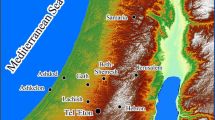Abstract
Macroscopic plant remains found in pisé material (clay or mud used in building), used as lining in pits at the Upper Egyptian Predynastic site of Adaïma were investigated. Comparison with assemblages from the sediment fills of these pits and with assemblages from other contexts in the same site demonstrated the taphonomical importance of pisé as a building material for the formation of the site’s archaeological sediment. In particular, the influence of the pisé plant temper on the composition of plant assemblages in the sediment fills of the pits was brought to the fore. The choice of specific plant materials for their use as temper in pisé or mud bricks is shown, in particular that of barley (Hordeum vulgare) threshing remains. The importance of cereal processing by-products as construction material is also assessed in a wider economic context and compared with later Egyptian mud brick plant contents.





Similar content being viewed by others
References
Anderson S, Ertug-Yaras F (1998) Fuel fodder and faeces: an ethnographic and botanical study of dung fuel use in Central Anatolia. Environ Archaeol 1:99–109
Charles M (1989) Introductory remarks on the cereals. Bull Sumer Agri 1:17–31
Debono F, Mortensen B (eds) (1990) El Omari: a Neolithic settlement and other sites in the vicinity of Wadi Hof, Helwan, Archäologische Veröffentlichungen 82. Von Zabern, Mainz am Rhein
Gast M, Sigaut F (eds) (1979) Les techniques de conservation des grains à long terme, 1. Leur rôle dans la dynamique des systèmes de cultures et des sociétés. Éditions du CNRS, Paris
Hayes W (1965) Most Ancient Egypt. The University of Chicago Press, Chicago
Hendrickx S, Huyge D, Newton C (2003) The walls of Elkab (in prep)
Henein N (1988) Mari Girgis, Village de Haute-Égypte. Bibliothèque d’Étude 94. IFAO, Cairo
Institut Égyptien (1862) Séance du 24 janvier 1862. (Ollivier) De la conservation des blés au moyen du trèfle en fleurs. – Discussion à ce sujet. – Avantage que procure le mélange du blé avec la paille pour sa conservation. Bull de l’Institut Égyptien 7:50–55
Kemp B (2000) Soil (including mud-brick architecture) In: Nicholson P, Shaw I (eds) Ancient Egyptian materials and technology. Cambridge University Press, Cambridge, pp 78–103
Midant-Reynes B (ed) (1996) Introduction. Archéo-Nil, 6
Midant-Reynes B, Buchez N (eds) (2002) Adaïma I : Économie et habitat. FIFAO 45. IFAO, Cairo
Miller N (1990) The use of dung as fuel: an ethnographic example and an archaeological application. Paléorient 2:71–79
Murray MA (2000) Cereal production and processing. In: Nicholson P, Shaw I (eds) Ancient Egyptian materials and technology. Cambridge University Press, Cambridge, pp 505–536
Newton C (2002) Environnement végétal et économie en Haute-Égypte à Adaïma au Prédynastique; approches archéobotaniques comparatives de la IIe Dynastie à l’Époque romaine. Unpublished PhD Thesis, Université Montpellier II, Sciences et Techniques du Languedoc
Reisner G (1931) Mycerinus: the Temples of the Third Dynasty Pyramid at Giza. Harvard University Press, Cambridge, MA
Samuel D (2000) Brewing and baking. In: Nicholson P, Shaw I (eds) Ancient Egyptian materials and technology. Cambridge University Press, Cambridge, pp 537–576
Thanheiser U (1999) Plant remains from Kellis: first results. In: Hope C, Mills A (eds) Dakhleh Oasis Project: preliminary reports on the 1992–1993 and 1993–1994 field seasons. Oxbow, Oxford, pp 89–93
Thompson D (1999) New and old in the Ptolemaic Fayyum. In: Bowman A, Rogan E (eds) Agriculture in Egypt from pharaonic to modern times. Proceedings of the British Academy 96. The British Academy/ Oxford University Press, New York, pp 123–138
Unger F (1862) Botanische Streifzüge auf dem Gebiete der Culturgeschichte. V. Inhalt eines ägyptischen Ziegels an organischen Körpern. Sitzungsberichte der Kaiserlichen Akademie der Wissenschaft, Mathematik-Naturwissenschaft Classe 38:75–88
Veen M van der (1999) The economic value of chaff and straw in arid and temperate zones. Veg Hist Archaeobot 8:211–224
Willcox G (2000) Présence des céréales dans le Néolithique précéramique de Shillourokambos à Chypre: résultats de la campagne 1999. Paléorient 26(1):129–135
Willcox G, Fornite S (1999) Impressions of wild cereal chaff in pisé from the tenth millennium at Jerf el Ahmar and Mureybet, northern Syria. Veg Hist Archaeobot 11:21–24
Willcox G, Tengberg M (1995) Preliminary report on the archaeological investigations at Tell Abraq with special attention to chaff impressions in mud brick. Arab Archaeol Epigraph 6:129–138
Acknowledgements
I thank Béatrix Midant-Reynes for giving me the opportunity to study the material from Adaïma. For the technical side, I thank the IFAO and Michel Wuttmann for the use of microscopes belonging to the conservation laboratory. I am thankful to George Willcox and an anonymous reviewer for their constructive remarks, and to Art Newton for correcting the language. This work was made possible by a PhD grant from the French Ministry of Education and Research (allocation de recherche), and by travel grants from the IFAO.
Author information
Authors and Affiliations
Corresponding author
Rights and permissions
About this article
Cite this article
Newton, C. Plant tempering of Predynastic pisé at Adaïma in Upper Egypt: building material and taphonomy. Veget Hist Archaeobot 13, 55–64 (2004). https://doi.org/10.1007/s00334-003-0025-4
Received:
Accepted:
Published:
Issue Date:
DOI: https://doi.org/10.1007/s00334-003-0025-4




